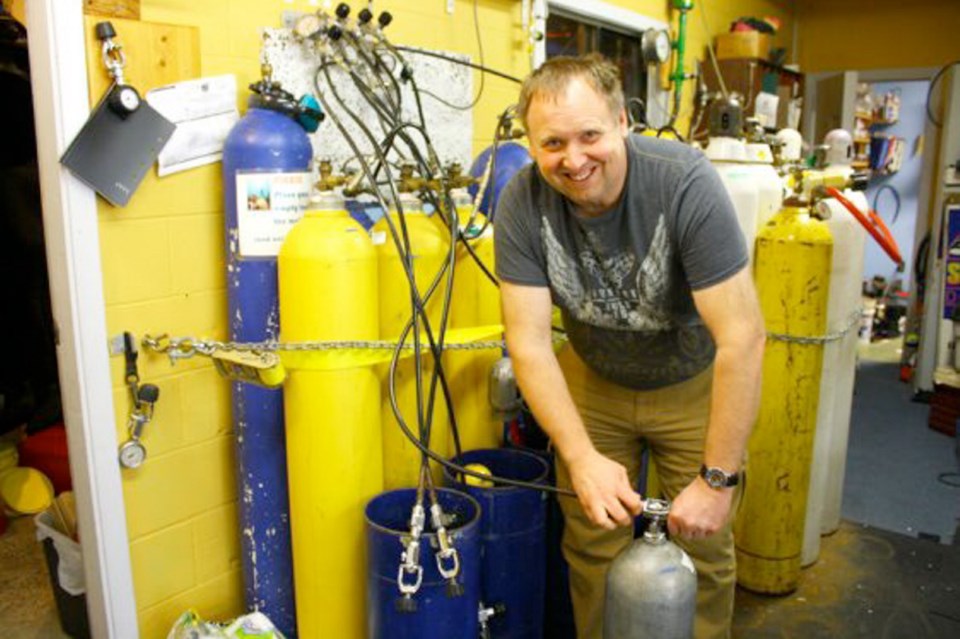A sea star-wasting disease that decimated the population of sunflower stars in the Vancouver area in a matter of weeks has been recently uncovered in Nanaimo.
Researchers are still puzzled about what is causing sea stars, commonly known as starfish, to go limp, have limbs fall off and crawl away, and within a matter of days or weeks, essentially turn to "goo" and rot.
The melting sea stars were first spotted in September in the Burrard Inlet/Howe Sound area, and then spread up the Sunshine Coast, said Dr. Jeff Marliave, vice-president of marine science at the Vancouver Aquarium.
The syndrome then showed up in Puget Sound in Seattle before it crossed to Vancouver Island. It has also been spotted on the California coast. In November it was spotted in both Nanoose and Nanaimo. Experts believe the sea star dieoff may be due to a pathogen that affects multiple species, however initial testing by scientists with Fisheries and Oceans Canada have not detected the presence of any pathogens thus far, said Lara Sloan, communications officer for the DFO. Further testing may be conducted in the coming months, she added.
Scientists at Cornell University, the University of California Santa Cruz, the Seattle Aquarium and a variety of other U.S.-based universities are currently scrambling to culture viruses and bacteria in the hope of finding a cause.
"We can't say that it's an infectious process, but it certainly seems that way," said Marliave.
Dive shop owner Ed Singer was surprised last month when he observed the wasting syndrome for himself on a cluster of starfish while diving to the Rivtow Lion shipwreck in Departure Bay.
"It was actually a group of starfish all together that looked like someone had put a big weight on them and mushed them," he said. "They were almost squished to the degree that they're dead. The ones that aren't quite dead looked like they were in really, really rough shape as well."
The longtime diver, who has been the owner of Sundown Diving for 30 years, said he finds it "alarming" to see the numbers of starfish affected.
"You know, you see the odd starfish that you wonder what's happened to it, but as far as numbers go, we haven't seen that (before). I don't know if it's a cycle that's going on that occurs every once in a while, but I've never seen it in all the time I've been diving," he said.
Marine naturalist and educator Andy Lamb, author of Marine Life of the Pacific Northwest, reported seeing starfish afflicted with the syndrome in Nanoose on Nov. 5 and in the water off Neck Point Park on Nov. 28.
"It's such a dynamic and fastmoving story that daily, things are happening," said Lamb.
"In Chemainus, we went over and did some diving where the Boeing 737 was sunk, and everything seemed to be okay, and we went back two weeks later and it was devastation. Just amazing."
The afflicted starfish in Chemainus were spotted in early December, and the same problem was found in Port Hardy as recently as last week, added Lamb. The story has captivated the imagination of divers everywhere, he said.
Lamb's observations, along with those of other divers and scientists, have been collated into an online map developed by the Vancouver Aquarium in the hope of providing some information about the wasting syndrome's spread.
At this point, however, until more data comes in, the mystery of the melting sea stars is far from solved.
It is unlikely the syndrome is due to radiation migration from the meltdown of Japan's Fukushima nuclear plant, said Marliave, as it would have been observed on the west coast of Vancouver Island first.
One possibility is that the increase in international shipping traffic may have played a role, as ballast water potentially containing foreign species or pathogens is regularly dumped from ships into the ocean.
"It could be that this is happening more dramatically because our global transport is taking bugs all over the world," he said.
According to a statement released by the University of California Santa Cruz, two common attributes to sites where the syndrome have been observed is that its effects are dramatic, and the period prior to wasting or melting was characterized by warmer water temperatures - making climate change a potential factor.
The syndrome may also be simply due to a natural check in the balance of sea star populations, which have been incredibly overpopulated for over a decade, Marliave added.
"The one thing I'm coming to realize is that this is probably the way that population is controlled in this group of animals."
Though the mature population of sunflower stars were completely wiped out in the Vancouver area, they are bouncing back, and new babies have been observed, he said.
Lamb said he plans to head out to Porlier Pass today with a friend to conduct a dive and monitor the health of starfish between Galiano and Valdez Islands.
Divers with cameras have been instrumental in documenting the syndrome, he said.
Any divers or marine observers who spot sea stars with the syndrome are encouraged to submit their findings and photos to the Vancouver Aquarium at [email protected] or online at www.vanaqua.org.



